EXTRACTION AND ANALYSIS OF M-11 FROM PRAIRE TURNIP EXTRACT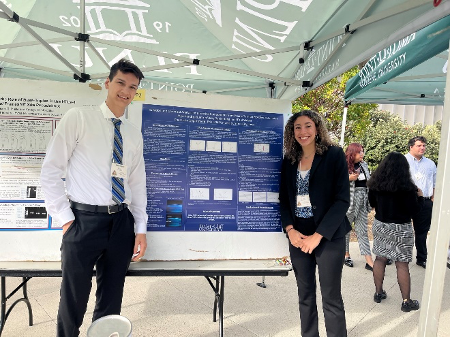
Quinten Vasa and Mya Hendry (Paul Weber and Daniel Jung)
Prairie turnip (Psoralea esculenta) is a plant indigenous to the Great Plains. It has historically been used by Native Americans as a food source and treatment for a variety of infections and inflammations. Amidst an increasingly health-conscious public and a revitalized interest in natural medicine, the prairie turnip serves as excellent candidate for future pharmacologic use. Previous studies at this institution have shown that an extract of the rind skin of the prairie turnip exhibits both antioxidant and antibacterial activity. Further investigations also traced these properties to a TLC band named M-11. The novelty of this study comes with the use of AnaltechTM TLC plates that allow for separation of M-11 into two distinct bands named light and dark band. HPLC is used to determine the purity of these bands. The light band was analyzed using mass spectrometry technique to gain more information on its structure and mass to charge ratio. Evidence provides that both the light and dark bands have been shown to have antibacterial and antioxidant properties. Analysis of M-11 structure is important because it can give insight to the mechanism of its antibacterial and antioxidant properties.
THE SIMULATION OF PHYSICAL EXERCISE USING HEAT ON RAT MYOBLAST CELLS 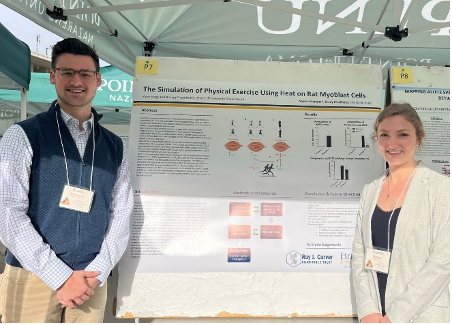
Sophie Kramper and Brady Brockhaus (Daniel Jung)
Exercise is known to induce hyperthermia to some extent. Hyperthermia is induced by the heat that is generated from muscular movement as a waste product of metabolism. This suggests that heat could serve as an indication of exercise occurring at the cellular level. Heat shock proteins are chaperones that cope with cellular stresses. Chaperones are known to refold proteins that have been damaged or misfolded by any stress, including hyperthermia. Recent human exercise studies showed that heat shock protein 72 (HSP 72) is highly expressed during chronic and acute exercise. We aim to simulate chronic and acute exercise by introducing heat at the cellular level. Rat myoblast - C2C12 – was chosen as a cellular model. C2C12 was selected because it can mimic muscular cells under specific conditions. Our previous research showed HSP 72 was highly upregulated at 46°C, which is irrelevantly high for any exercise situation. In this study, we aim to delineate the kinetics of HSP 72 expression at various temperatures. C2C12 was treated at 37°C, 38°C, and 46°C for approximately 1 hour. Cell viability was frequently checked by microscope. The RNA was extracted and converted to complementary DNA. Complementary DNA was used to detect the gene expression of HSP 72. We found that HSP 72 is expressed similarly at 38°C compared to 46°C. This means that HSP 72 levels at 1°C higher than normal physiological temperature shows similar results as at 46°C. This research provides the evidence that exercise may be simulated at the cellular level.
THE MECHANISM OF ANTI-INFLAMMATORY PROPERTIES OF PRAIRIE TURNIP EXTRACTS COMPONENT M11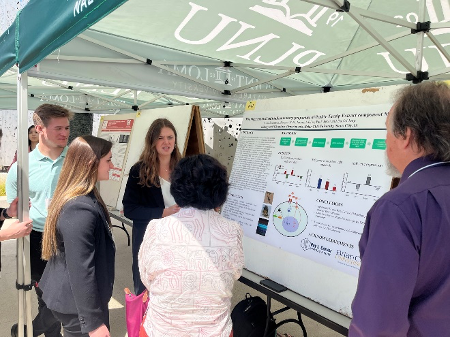
Anna Sorenson, Kaegan Held, and Jeremiah Glise (Paul Weber and Daniel Jung)
Native Americans have used the Iowan prairie turnip (Psoralea esculenta) as a source of various bioactive compounds that benefit health by reducing inflammation. Previous studies showed that prairie turnip extracts (PTE) induce the expression of indoleamine 2, 3-dioxygenase, (IDO). Furthermore, PTE contains the unreported active component, M11. M11 possesses antibacterial and antioxidant properties. IDO is an immune response modulator that is present in various cells. It functions by catabolizing tryptophan to help reduce inflammation. Previous research showed that the mechanism of this induction was mediated by AhR (Arylhydrocarbon receptor) in macrophages. This study’s goal was to uncover the mechanism of reducing inflammation by using HeLa cells treated with PTE. HeLa cells are a cell-line model for epithelial cells which cause the cascade of inflammation. It was hypothesized that the PTE would induce the expression of IDO, a marker for anti-inflammation. Interleukin-27 (IL-27) is a cytokine that regulates inflammation by regulating IDO transcriptionally. Inflammation can be caused by the insult of epithelial cells, so HeLa cells (cervical epithelial cells) were treated with M-11. To test the hypothesis, the level of mRNAs for IDO and IL-27 were quantified by performing a series of reverse transcriptase real-time polymerase chain reactions. Results showed that M-11 upregulates IDO mRNA levels, which indicates the anti-inflammatory status of cells and concludes that IDO was expressed. Results showed that the mechanism of this upregulation may be mediated by IL-27. This study shows the cell type-dependent regulation of IDO, which could contribute to anti-inflammatory drug development.
IDENTIFICATION OF NITROGEN REMOVAL BACTERIA FROM THE WASTEWATER IN THE CITY OF SIOUX CITY WASTEWATER TREATMENT PLANT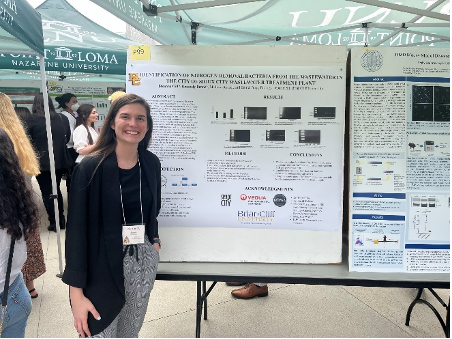
Breanna Gill, Kennedy Benne, and Mathew Griesel (Daniel Jung)
Nitrogen is one of the essential elements in living organisms, however inappropriate discharges of nitrogen in wastewater cause adverse effects, such as toxic algae proliferation, groundwater contamination, and generation of atmospheric gas contributing to global warming. Both physicochemical and biological processes have been used to remove excess nitrogen from the wastewater. The process of biological removal of nitrogen that requires nitrification by ammonium oxidizing bacteria (AOB) and nitrite-oxidizing bacteria (NOB) under aerobic conditions and denitrification by nitrate-reducing bacteria (NRB) under anoxic conditions is known to be more cost-effective than other processes. Current methods employed by Sioux City require a lot of aeration energy, carbon source, and use of alkalinity. To save aeration energy, carbon source, and alkalinity, removal of nitrogen by anaerobic ammonium oxidation via utilization of anammox would be ideal. The City of Sioux City WWTP established a pilot plant to apply the anammox process pilot to test whether this process is feasible to remove the ammonium nitrogen of the waste from the dewatering process of anaerobic digestion. To better understand the results from pilot-scale testing and implement them successfully for a full-scale plant in the future, it is important to understand the ecology of microbial populations that are essential for this process. This study is focused on the microbial ecosystem of the wastewater treatment process in Sioux City WWTP. Real-time PCR analysis and conventional PCR of ribosomal genes showed the existence of AOB, NOB, and Annamox. Current research is focused on understanding microbial interplay at the pilot plant.
CHLOROFORM INDUCES IDO FOR UNIQUE TUMOR ENVIRONMENT VIA INTERLEUKIN-27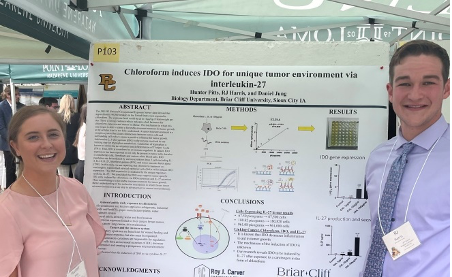
Hunter Pitts and RJ Harris (Daniel Jung)
The 1981-83 National Occupational Exposure Survey data showed that approximately 96,000 workers in the United States were exposed to chloroform. The exposure level could be up to 10μg/kg of bodyweight per day. There is strong evidence which indicates a link between this chloroform exposure and cancer incidence. The mechanism in which this carcinogen is able to create a favorable microenvironment for tumor growth at the cellular level is not fully understood. A tumor microenvironment is a complex system that causes interactions between tumor cells and surrounding cells which causes a positive influence for tumor growth. Indoleamine 2, 3-dioxygenase (IDO) is the enzyme involved in rate limiting step for tryptophan metabolism. Catabolites of tryptophan is known to inhibit the development and differentiation of T helper 1 cells (TH1). Thus, IDO is considered as an immune regulator. In cancer, IDO expression has been reported to not only be present in tumor cells, but also in endothelial cells, fibroblasts and various white blood cells. IDO regulation can be mediated by various cytokines from T cells including IL-4, IL-10, IL-27, interferon gamma (IFN), and tumor necrosis factor alpha (TNF). In this study, we are reporting that chloroform treatment on carcinogenic transformed cervical epithelial cells (HeLa cells) induces IDO expression. This IDO expression is mediated by the unique regulatory cytokine, IL-27. We concluded that IDO may suppress tumor specific TH1 cells, induced by chloroform via IDO expression and IL-27 secretion. Thus, contributing to a favorable microenvironment for tumor growth. Better understanding of the molecular mechanism in which favors tumor microenvironment is a key step to advancement in cancer immunotherapy.
Learn more about all presentations.